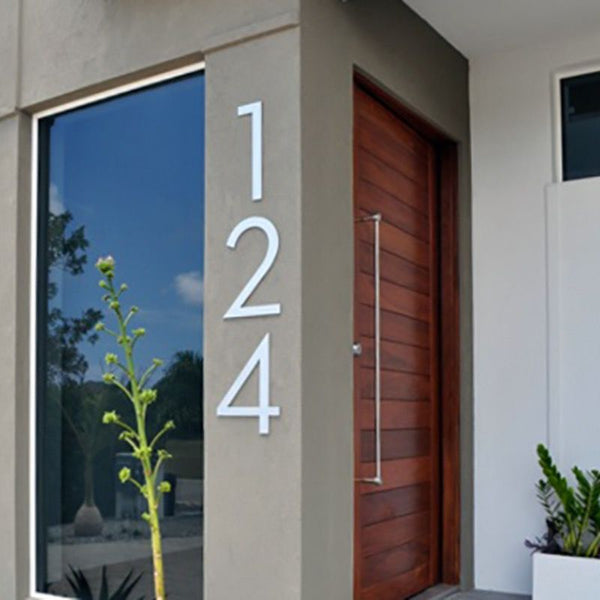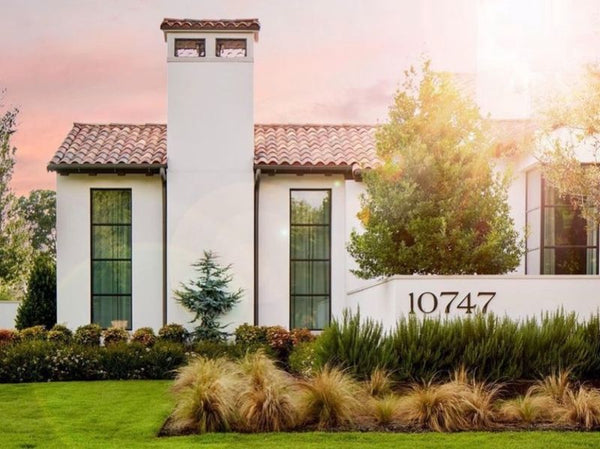Most homes blend into their surroundings; not because they’re poorly designed, but because the finer details are overlooked. Custom house numbers are one of those details. They're not just identifiers; they're statements. Well-designed signage enhances curb appeal, complements architecture, and improves functionality. But standing out doesn’t mean going over the top; it means making informed design choices that align with your space and style.
This guide takes you beyond trends. We’ll explore the real purpose of house numbers, how materials, sizes, and placement influence visibility, and why customization offers both aesthetic and practical value. Whether you're updating a mid-century home or designing a modern facade, you’ll walk away with tools to create house numbers that do more than identify; they elevate.
Why House Numbers Matter More Than You Think
House numbers are often the first thing people notice; even before the color of your door or the shape of your porch. They serve three essential functions:
-
Wayfinding: Helping visitors, delivery personnel, and emergency services locate your home efficiently.
-
Aesthetics: Contributing to your home’s first impression and exterior design.
-
Personalization: Reflecting your taste, lifestyle, and attention to detail.
Failing to consider their design can lead to readability issues, mismatched styles, or missed impressions. Done right, they become an integrated design feature.
Built Better: Why Our House Numbers Lead the Industry
Creating standout house numbers isn’t just about aesthetics; it’s about quality, visibility, and thoughtful design. At Modern House Numbers, we combine design intelligence with material integrity to deliver house numbers that perform as well as they look. Here’s why informed homeowners, designers, and architects trust us:
Human-Centered Design Philosophy
Our process begins with a simple idea: your address should be functional art. We don’t just consider trends; we study how people interact with spaces. The height, weight, spacing, and finish of every number is carefully engineered for clarity, contrast, and modern appeal. The result? Numbers that aren’t just readable; but remarkable.
Field-Tested Readability Standards
House numbers are meant to be seen; day or night, sun or snow. That’s why we design each product around proven visibility metrics, including ideal mounting heights, stroke width, and reflective contrast. Whether you live on a winding hillside road or a shaded cul-de-sac, your numbers stay legible from the street.
Precision Manufacturing Practices
We don't rely on automated, impersonal production lines. Our numbers are CNC-machined to exact specifications, ensuring consistency in every curve, angle, and edge. Each unit is inspected by hand; because small flaws can impact durability, alignment, and long-term performance.
Sustainable Material Sourcing
Longevity isn’t just a performance metric; it’s a sustainability measure. We use responsibly sourced metals and low-waste cutting techniques to minimize environmental impact. Our finishes are low-VOC and free from harsh chemicals, ensuring cleaner production with less harm to people or planet.
Intuitive Mounting Systems
A great design means little if it’s difficult to install. That’s why our numbers include installation templates that are easy and hardware that simplify alignment and spacing. You don’t need to be a contractor to get professional-grade results; our system empowers DIYers with confidence and clarity.
Collaborative Support for Designers and Homeowners
We work closely with professionals and individuals alike. Whether you’re redesigning a single-family home or specifying numbers for an entire development, our team offers personalized consultations to help guide the layout, finish, and sizing that fits your architecture.
Compliance and Best Practices
We have made every effort to align our designs to meet USPS address visibility guidelines and align with municipal code standards. We help homeowners avoid common mistakes like incorrect sizing, poor contrast, or non-compliant placement; factors that affect emergency response, delivery accuracy, and neighborhood consistency. Check with your local municipality standards prior to making a purchase as each municipality sets their own standards.
Built for Real Environments
From desert heat to coastal moisture, our numbers are tested in real-world conditions. We consider things like UV exposure, salt spray, and temperature swings; so what looks good today still performs a decade later. If you live in a harsh environment we recommend using one of our powder coated finishes.
What Makes a House Number Stand Out?
Standing out doesn’t always mean being bold or flashy. It means being clear, intentional, and appropriate to your home. Here are the most influential design elements:
1. Font Style and Readability
The font is not just about looks; it's about legibility. Key considerations:
-
Sans-serif fonts (like Palm Springs or SoCal) are clean and modern.
-
Serif fonts offer a traditional or vintage feel (like Santa Barbara).
-
Avoid decorative scripts that reduce visibility from the street.
-
Choose fonts that are thick, consistent, and evenly spaced.
Remember: readability is crucial from both aesthetic and safety standpoints.
2. Size and Proportions
One of the most common mistakes is using numbers that are too small. General sizing rules:
-
From 25 feet away, numbers should be at least 4 inches high.
-
For better visibility at 50+ feet, aim for 6–8 inches or more.
-
Ensure proportion with your home’s façade; numbers should not get lost in scale.
Larger doesn’t always mean better. Balance is key.
3. Color Contrast and Finish
Contrast determines how well your numbers pop against the background. A good rule of thumb:
-
Dark numbers on a light wall (e.g., black on white).
-
Light numbers on a dark wall (e.g., brushed aluminum on slate).
-
Avoid colors that blend too closely with their backdrop.
Matte finishes reduce glare and improve readability. Glossy finishes may add drama but can reflect sunlight and obscure clarity.
4. Placement and Orientation
Where you install your numbers is just as important as how they look.
-
Mount numbers near primary entry points (door, gate, mailbox).
-
Keep them 4–6 feet from the ground for optimal viewing.
-
Ensure they're not blocked by plants, railings, or décor.
-
For horizontal orientation, keep spacing even and consistent.
-
Vertical installations work best in narrow spaces or for dramatic effect.
Well-placed numbers feel purposeful and are easier to spot.
Choosing the Right Material for Longevity and Style
The material affects durability, weather resistance, and visual tone. Below are some of the most popular choices:
Aluminum
-
Lightweight, corrosion-resistant, and modern in appearance
-
Often comes in brushed, matte, or powder-coated finishes
Brass or Bronze
-
Warm, traditional tones ideal for vintage or colonial homes
-
Develops a natural patina over time
Stainless Steel
-
Sleek and minimalist
-
Highly resistant to rust and discoloration
-
Works well with glass, concrete, and stone exteriors
Acrylic or PVC
-
Affordable and versatile
-
Often used for colorful or playful designs
-
Best for sheltered areas, as they may fade over time
Choosing the right material is a balance between aesthetic preference, environmental exposure, and budget.
Design Tips for Creating Custom House Numbers
Customization allows you to integrate numbers as a design element. Use these principles to guide your process:
1. Align with Architectural Style
Choose the best house numbers that complement; not compete with; your home’s architecture.
|
Home Style |
Recommended House Number Style |
|
Modern |
Minimal fonts, clean lines, floating mount |
|
Craftsman |
Wood accents, earth tones, serif fonts |
|
Mid-Century |
Geometric fonts, bold sizes, aluminum or steel |
|
Farmhouse |
Rustic finishes, black metal, traditional fonts |
|
Colonial |
Brass or bronze, serif or old-style fonts |
2. Experiment with Layouts
Custom layouts give your space a signature touch:
-
Floating numbers with spacers for a shadow effect
-
Stacked vertical arrangements for tall, narrow posts
-
Mixed materials (e.g., wood backplate with metal numbers)
-
Laser-cut number plates with negative space
Your goal is cohesion. Let the numbers amplify; not fight; your entryway’s design.
3. Light It Up
Backlit or spotlighted numbers are not just for aesthetics. They:
-
Improve night visibility
-
Highlight design features
-
Add safety and guidance for emergency responders
Solar-powered lights are a sustainable, low-maintenance option.
Common Mistakes to Avoid
Even well-designed numbers can fall flat if a few key things are overlooked:
-
Too small to be visible from the street
-
Poor contrast with background color
-
Placed behind foliage or decorative elements
-
Mounted unevenly or with inconsistent spacing
-
Using overly ornate or unreadable fonts
Test your design from the curb before installing. Readability from a distance matters more than up-close detail.
When to Update or Replace House Numbers
Sometimes even minor updates can refresh your entire entryway. You should consider replacing your numbers when:
-
Paint or finish has faded or chipped
-
Style no longer matches a renovated home exterior
-
They're too small for updated street visibility standards
-
Numbers don’t meet fire code or city regulations
-
They're difficult to read during evening hours
Replacements don’t have to be dramatic; just thoughtful and well-executed.
How Customization Affects Curb Appeal and Resale Value
Custom house numbers aren’t just décor; they’re real value-adders:
-
Creates a cohesive look that buyers notice instantly
-
Signals maintenance and care in the rest of the property
-
Improves first impressions in photos or drive-bys
-
Meets municipal requirements for emergency visibility
In real estate, details matter. Custom numbers are one of the cheapest, easiest upgrades with tangible return.
Frequently Asked Questions
1. Why should I customize my house numbers?
Custom house numbers enhance curb appeal and reflect your personal style. They make your home more noticeable and inviting while ensuring visitors and delivery drivers can easily locate your property.
2. What materials can I use for custom house numbers?
You can use various materials like aluminum, wood, metal, stone, glass, or even recycled items like bottles. Each material offers unique textures and styles, allowing you to match your home's aesthetic.
3. How can I make my house numbers more visible at night?
Consider illuminated or reflective house numbers using LED lights, solar-powered options, or high-contrast colors. These not only improve visibility but also add a modern and practical touch to your home.
4. Are there DIY options for creating custom house numbers?
Yes, DIY options include projects like using cedarwood backdrops, mosaic tiles, or spray-painted designs. These approaches allow for creativity and personalization while being cost-effective.
5. What design tips ensure my house numbers stand out?
Use bold fonts, high-contrast colors, and unique placements like floating designs or vertical stacking. Incorporating artistic elements that complement your home's architecture can further elevate the look.
Ready to Start Designing Your Custom House Numbers?
Designing standout house numbers isn’t about being flashy; it’s about intention, visibility, and harmony with your space. From selecting the right material to perfecting your layout and contrast, every decision adds to both form and function.
When you're ready to elevate your exterior with house numbers that reflect your style, visit Modern House Numbers. Their customizable options are built for visibility, durability, and timeless appeal; backed by design expertise that brings your vision to life.



